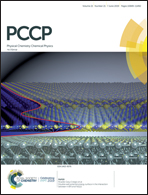The metallo-formate anions, M(CO2)−, M = Ni, Pd, Pt, formed by electron-induced CO2 activation
Abstract
The metallo-formate anions, M(CO2)−, M = Ni, Pd, and Pt, were formed by electron-induced CO2 activation. They were generated by laser vaporization and characterized by a combination of mass spectrometry, anion photoelectron spectroscopy, and theoretical calculations. While neutral transition metal atoms are normally unable to activate CO2, the addition of an excess electron to these systems led to the formation of chemisorbed anionic complexes. These are covalently bound, formate-like anions, in which their CO2 moieties are significantly reduced. In addition, we also found evidence for an unexpectedly attractive interaction between neutral Pd atoms and CO2.

- This article is part of the themed collection: 2019 PCCP HOT Articles


 Please wait while we load your content...
Please wait while we load your content...